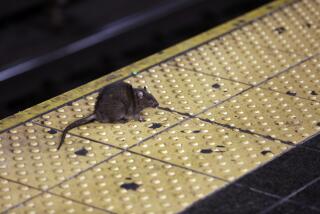More on Kangaroo Rats
- Share via
This is in response to Charles Bragg’s comments (Letters, July 23) on my letter regarding the Stephens’ kangaroo rat. My comments regarding the subspecies was not to suggest they be destroyed, but rather questioning if the subspecies was something that deserves saving.
There is wide disagreement among biologists over how to distinguish one kangaroo rat from another. Maybe they really are not different at all.
If we applied the same distinctions to people, e.g. the red-haired, blue-eyed subspecies vs. the red-haired, green-eyed subspecies, etc., we would be appropriately considered racists, bigots or worse. But when applied to animals, the most minute difference seems to designate a fully separate class.
Bragg obviously doesn’t understand the economics of building. The new-home buyer pays for the new sewer, water lines, electric, etc., as such costs are paid by the builder and included in the price of the home. So Bragg can take comfort that he’s not contributing to the welfare of other humans whatsoever. My point regarding the rat habitat fee is that it is being imposed on home buyers in wide areas of Riverside County, not just those buying homes built on land where the rat is found.
Why should someone buying a house in Rancho California, Moreno Valley or Corona who may not care about saving the rat, pay a fee to create a habitat for rats that were not on the land where their home is being constructed, while Bragg, who wants to save the rat, pays nothing.
What I suggested is that if we as a society decide to spend $150 million to $300 million (yes, $100s of millions) to buy a habitat for a rat, that burden should be borne by society as a whole, including Bragg, not just new-home buyers in Riverside County.
ALAN L. NEWMAN
Rancho Cucamonga
Newman is vice president of Friedman Homes.
More to Read
Sign up for Essential California
The most important California stories and recommendations in your inbox every morning.
You may occasionally receive promotional content from the Los Angeles Times.













